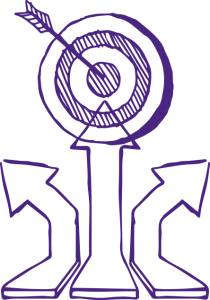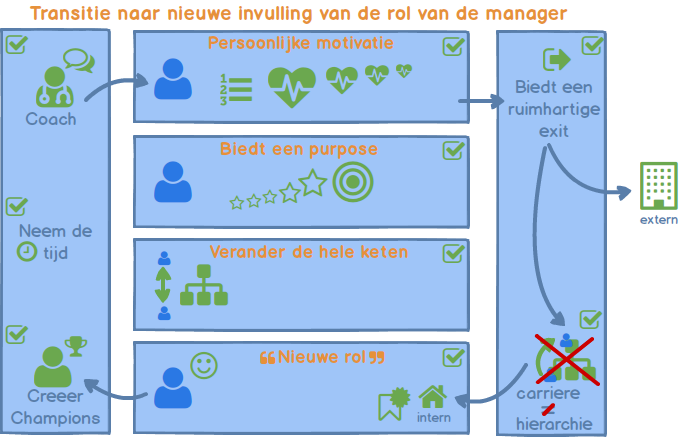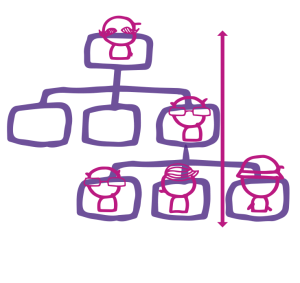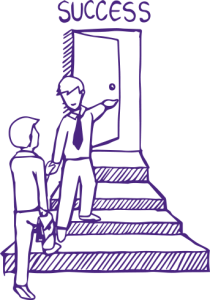How to help management towards servant leadership?
During a recent Management 3.0 training I provided one of the attendants had a question on how we could help management towards a change in their role. How can we motivate middle management in particular because for them a management transition towards servant leadership potentially has such a huge impact. How do we deal with the question “If I am going to loose control because I am supposed to delegate authority downwards, what is it that I get back?”
This question led to a good discussion in the group, but even after the course the question stuck to me. It is an important question that deserves a thorough answer. And that’s the reason for this article. In this article I will attempt to provide suggestions on ways to help management fulfill a different role. I will try to use the tools and knowledge that Management 3.0 provides.
A little bit of background information: Management 3.0 is a body of knowledge that concerns itself with a different way of fulfilling the role of management in organizations. It replaces direct control of people with the creation of an environment in which employees can be motivated, can take control, and can learn continuously. The need for this different role of management is twofold: On one side the environment of organizations is changing increasingly fast and is rapidly getting more complex. Traditional management methods do not handle this complicity very well. On the other side it just makes work more fun, which eventually will also lead to better results as is indicated by numerous research.
Organization with a desire to become more adaptive can use Management 3.0 principles to achieve this. For teams and individuals this often has a direct positive impact because they get more autonomy, more chances to take initiative and opportunities to develop themselves. For senior management it is a strategic choice they deem necessary for the long term succes of the company. But for middle management, as we often experience in our consultancy work, this change has the biggest impact. They have to let go of a style of management that has been imprinted in their minds for years. They are suddenly expected to to adopt practices that feel alien to everything they have ever learned on the subject of management. Many times they have to implement this change while they are still being ‘managed the old way’ themselves. No easy job. In this situation it seems a very relevant question: How can we help the manager in this transition?
The original question was formulated in terms of “We are taking something away from the manager. What does he get back in return?” I think this is a bit of a trap. It can understandingly be the line of reasoning for the manager in question himself, but I think we must be careful to follow him in this line of reasoning. It is not a simple exchange. The ’thing’ we are taking away is something that has been an intrinsic part of the manager’s fundamental believes on management for years: “If I am to be responsible for something, I expect to have the authority that comes with it”. He knows how to do his job the current way through and through. The new way of management is probably largely uncharted territory for him. And even for someone who truly believes in the need for change, it is going to take a while to really appreciate ‘what you got back’. Besides, ’taking something away’ suggests a sudden change, and reality teaches us that a careful coaching is crucial. And even then it will often feel as a sudden change anyway, because the positive consequences are only seen later.
So what are the step we can take?
Start with personal motivation
Start with gaining insight in what the person in question truly motivates. A helpful tools for this within the Management 3.0 toolkit is Moving Motivators, which is a set of 10 intrinsic and extrinsic motivators we can use to get an understanding of what matters to someone and get him going. Some people are motivated by status for example. For others the relationship with coworkers is very important.
So we start with personal motivation. The tool offers a set of cards, one for each of the 10 motivators. Ask the person in question to rank the cards in order of importance. Which motivator is most important for him in the context of work? Which ones are less important. Having a conversation on the ranking is the real value of course because then you will explore why some motivators are so important to someone.
The second step indicates whether certain motivators are positively or negatively influenced by someone’s current role. Imagine someone values status. Does the current role fulfill that motivator in a positive or negatieve way? Ask for actual examples. Move motivator card that are positively triggered up, and negatively triggered motivators down. This creates a visual image that of course is something to discus again.
Next we do the same looking at the expectation of the new contents of the management role. Are some important motivators that were triggered positively so far now expected to be triggered in a negative manner?
These steps of course provide some important insight to the change team. But more important is the insight for the manager himself. I have experienced that a manager expected some motivators to get negatively triggered by her new role, but she also discovered some other motivators were potentially triggered in a positive way. These are the first step in coaching. This also touches the second goal of this focus on motivation: it gives the manager the feeling that his personal motivation matters. We are not simply taking something away and give something in return. We go on a journey that fulfills a new role in a way in which personal motivations matter.
Purpose
 Dan Pink points out that organizations should spend more time on asking WHY we do something and less on HOW the work should be done. He has illustrated this with an example of a research study that was conducted among call center volunteers at a major US University. The call center workers participated in fund raising for valuable scientific research. The researches divided the workers into three groups: One group spend five minutes of reading letters from former call center workers explaining which personal benefits the work had brought them, before they started calling. The second group also read letters for five minutes, but this time they where from people that had received funds and explained what valuable research the money was spend on. The third group was a control group and were allowed to spend the five minutes anyway they wanted. The two groups that read letters before calling outperformed the control group by far. But the group that read letters on the impact of the donations raised twice as much money as the other group!
Dan Pink points out that organizations should spend more time on asking WHY we do something and less on HOW the work should be done. He has illustrated this with an example of a research study that was conducted among call center volunteers at a major US University. The call center workers participated in fund raising for valuable scientific research. The researches divided the workers into three groups: One group spend five minutes of reading letters from former call center workers explaining which personal benefits the work had brought them, before they started calling. The second group also read letters for five minutes, but this time they where from people that had received funds and explained what valuable research the money was spend on. The third group was a control group and were allowed to spend the five minutes anyway they wanted. The two groups that read letters before calling outperformed the control group by far. But the group that read letters on the impact of the donations raised twice as much money as the other group!
People are motivated by a higher purpose if that purpose is clear and they know how to contribute to it. Even more so if the purpose aligns with their personal goals and values. So don’t start with HOW the new role of management should look like, but start with the question WHY we are making this change in the first place. Be crystal clear on the purpose of the organization, and give management the opportunity to align their personal goals with the goals of the organization. Don’t be surprised if some managers get so engaged in the process they start looking for new ways to fulfill the management role in line with the company purpose by themselves.
Offer a generous exit
 Helping managers through a change also means helping them to gain insights whether the new role really fits them or not. Don’t expect everybody to be able or willing to take the journey with you. And that should be ok. If the new role does not trigger any personal motivation in a positive way, you will not be doing that person, or the organization for that matter, any favor to force someone into the new role.
Helping managers through a change also means helping them to gain insights whether the new role really fits them or not. Don’t expect everybody to be able or willing to take the journey with you. And that should be ok. If the new role does not trigger any personal motivation in a positive way, you will not be doing that person, or the organization for that matter, any favor to force someone into the new role.
It is important to be transparent that the conclusion that a new role does not fit is an acceptable outcome. It is not a personal failure. Offer a generous exit as part of the transition, and be very transparant on this upfront. Realize that it is the organization itself that is responsible for the current management style in the first place. We created the type of managers we know expect to change in a way that differs fundamentally from anything they were ever taught on management. So senior leaders must take responsibility for anyone that is not able to follow in this change.
What does this mean exactly? Take your time for this transition. Don’t force people to fundamentally change their style of management overnight. Sending them to a course is not enough.
Help people towards another job is they are not able or willing to follow the change. This can also be a new job/role within the company! Many organizations we encounter silently broadcast the message that the only way to have a sustainable career in the company is the way up. Moving up the management ladder. But the modern management we are talking about changes more than just the job description of managers: the emphasis on the hierarchical structure of the organization need to lessen as well. After all, we are delegating authority downwards. For some (ex) managers this can feel as a liberation: finally they can find the time to actually work on something and get things done. Many managers have missed the satisfaction of actually accomplishing some task more then they are willing to admit. Embracing Management 3.0 does not entail we have less management as an activity, but it does mean we have less people that are dedicated managers. Management as an activity will be distributed more broadly throughout the organization. But this also can accomplish a new appreciation for craftsmanship as a way to make a career.
Change the entire chain
A phenomenon we often encounter is that senior management decides things need to change: employees and teams need te become self-organizing. Middle management need to execute this change by delegating decisions and responsibility downwards. But senior management itself does not change (at least for now). This creates a very difficult situation for middle management: they are expected to decentralize control, while at the same time they are themselves still managed the old way in a command-and-control fashion. We often see that middle managers are still held directly accountable for the people that ‘report’ to him or here.
My advise is very clear: Change the entire chain of authority, both below AND above the middle manager.
Use the chain to determine the needs of people towards middle management in the new situation. Ask teams what they need from the manager to be successful. Ask senior management what they expect from middle management. This creates both clarity and support.
Coaching
By now it should be clear that thorough coaching is imperative for a smooth transition to a new management style. The most important advice is to take your time. A fast instrumental intervention in which the new management role is determined by others than those are going to fulfill it will not work. There’s a famous quote of Peter Drucker called ““Culture eats strategy for breakfast”. An instrumental intervention does not change values, beliefs, informal contacts, and habits. And in the end nothing will change because of this. Culture will always be stronger then imposed processes, rules, and procedures. You need to realize that a change of the role of management is nothing less than a change of culture.
Coaching means training and helping the group of managers, but also personal coaching. Coaching also means managers are involved in defining the new management role.
Another advice is to start a buddy system that allows managers to support each other and learn form each other. This contributes to reflection on the new role, and they can help each other in challenging situations that will no doubt arise.
Coaches will have to be external at first. Because who in the organization is totally free of the principles, values, styles, and habits that we are trying to change? Even the most enthusiastic pro-change manager has to work within the current context and therefore will be influenced by it. But in the end the force for sustainable change needs to come form inside. It is too important to leave to external coaches. So an important task of external coaches is to create internal champions that support and in the end take over the job of the external coach.
Conclusion
The transformation towards an agile adaptive organization calls for a fundamental change of the role of management. Because the new role of management differs so fundamentally from what has been the standard for decades it is imperative that coaching and helping management in this transition is taken seriously. Paying attention to the personal motivators of managers is one important stap. A clear purpose that managers can align with their personal goals, beliefs, and motivators is another. It is crucial to change the entire management chain, not just middle management. Personal coaching, in conjunction with a buddy system, is aimed at creating internal champions. And for those who are not able or willing to make the transition the organization should offer a generous exit that displays the responsibility the organisation has in creating the kind of managers people need to change form in the first place.






